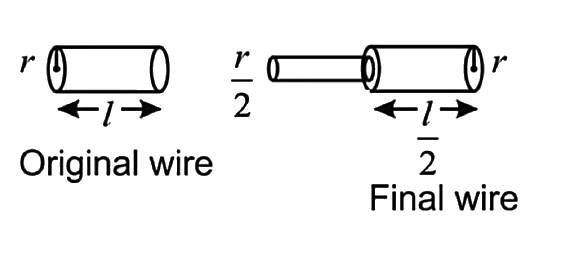A wire of length l is stretched to 4l length keeping volume constant. Then, the new resistance becomes
4 times
2 times
16 times
10 times
The correct Answer is:c
To solve the problem, we need to determine the new resistance of a wire that has been stretched to four times its original length while keeping its volume constant. Let's break down the steps:
Step 1: Understand the relationship between resistance, length, and area
The resistance R of a wire is given by the formula:
R=ρlA
where:
- R is the resistance,
- ρ is the resistivity of the material,
- l is the length of the wire,
- A is the cross-sectional area of the wire.
Step 2: Define the initial conditions
Let the initial length of the wire be l and the initial cross-sectional area be A. The initial resistance R1 can be expressed as:
R1=ρlA
Step 3: Determine the new length and area after stretching
The wire is stretched to a new length l′=4l. Since the volume of the wire remains constant, we can express the volume before and after stretching:
Initial Volume=A⋅l
Final Volume=A′⋅l′=A′⋅(4l)
Setting these two volumes equal gives us:
A⋅l=A′⋅(4l)
We can cancel l from both sides (assuming l≠0):
A=4A′
This implies:
A′=A4
Step 4: Calculate the new resistance
Now we can calculate the new resistance R2 using the new length and area:
R2=ρl′A′=ρ(4l)A/4
Substituting A′:
R2=ρ(4l)A/4=4⋅4ρlA=16ρlA
Step 5: Relate the new resistance to the initial resistance
From our initial resistance R1=ρlA, we can express the new resistance as:
R2=16⋅R1
Conclusion
Thus, the new resistance becomes 16 times the initial resistance.
New Resistance=16⋅R1
Final Answer
The new resistance becomes 16 times the initial resistance.
---
The resistance R of a wire is given by the formula:
R=ρlA
where:
- R is the resistance,
- ρ is the resistivity of the material,
- l is the length of the wire,
- A is the cross-sectional area of the wire.
Let the initial length of the wire be l and the initial cross-sectional area be A. The initial resistance R1 can be expressed as:
R1=ρlA
The wire is stretched to a new length l′=4l. Since the volume of the wire remains constant, we can express the volume before and after stretching:
Initial Volume=A⋅l
Final Volume=A′⋅l′=A′⋅(4l)
Setting these two volumes equal gives us:
A⋅l=A′⋅(4l)
We can cancel l from both sides (assuming l≠0):
A=4A′
This implies:
A′=A4
Now we can calculate the new resistance R2 using the new length and area:
R2=ρl′A′=ρ(4l)A/4
Substituting A′:
R2=ρ(4l)A/4=4⋅4ρlA=16ρlA
From our initial resistance R1=ρlA, we can express the new resistance as:
R2=16⋅R1
Thus, the new resistance becomes 16 times the initial resistance.
The new resistance becomes 16 times the initial resistance.
Similar Questions
The resistance of a wire R Ω . The wire is stretched to double its length keeping volume constant. Now, the resistance of the wire will become
View SolutionStatement I: A wire of uniform cross-section and uniform resistivity is connected across an ideal cell. Now the length of the wire is doubled keeping volume of the wire constant. The drift velocity of electrons after stretching the wire becomes one-fouth of what it was before stretching the wire.
Statement II: If a wire (of uniform resistivity and uniform cross section) of length l0 is stretched to length nl0, then its resistance becomes n2 times of what it was before stretching the wire (the volume of wire is kept constant in stretching process). Further at constant potential difference, current is inversely proportional to resistance. Finally, drift velocity of free electron is directly proportional to current and inversely proportional to cross-sectional area of current carrying wire.
View Solution
Knowledge Check
A cylindrical rod is reformed to half of its original length keeping volume constant. If its resistance before this change were R, then the resistance after reformation of rod will be
ARBR/4C3R/4DR/2A wire with 15ohm resistance is stretched by one tenth of its original length and volume of wire is kept constant. Then its resistance will be
A15.18ΩB81.15ΩC51.18ΩD18.15Ω
A wire is stretched to n times its length. Then the resistance now will be increase by
View SolutionIf a uniform wire of resistance R is uniformly strethced to n times the orginal length , then new resistance of the wire becomes
View SolutionA wire of resistivity is stretched to double its length. What will be its new resistivity?
View SolutionIf a wire is stretched to double its length, find the new resistance if the original resistance of the wire was R.
View SolutionA wire of length l has a resistance R. If half of the length is stretched to make the radius half of its original value, then the final resistance of the wire is

View SolutionA given wire of resistance 1 Ω is stretched to double its length. What will be its new resistance ?
View Solution
